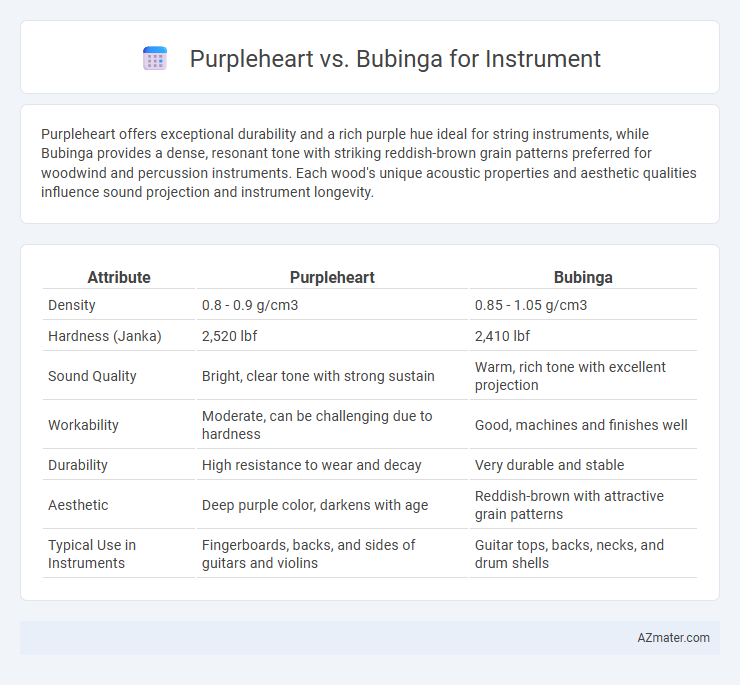Purpleheart offers exceptional durability and a rich purple hue ideal for string instruments, while Bubinga provides a dense, resonant tone with striking reddish-brown grain patterns preferred for woodwind and percussion instruments. Each wood's unique acoustic properties and aesthetic qualities influence sound projection and instrument longevity.
Table of Comparison
| Attribute | Purpleheart | Bubinga |
|---|---|---|
| Density | 0.8 - 0.9 g/cm3 | 0.85 - 1.05 g/cm3 |
| Hardness (Janka) | 2,520 lbf | 2,410 lbf |
| Sound Quality | Bright, clear tone with strong sustain | Warm, rich tone with excellent projection |
| Workability | Moderate, can be challenging due to hardness | Good, machines and finishes well |
| Durability | High resistance to wear and decay | Very durable and stable |
| Aesthetic | Deep purple color, darkens with age | Reddish-brown with attractive grain patterns |
| Typical Use in Instruments | Fingerboards, backs, and sides of guitars and violins | Guitar tops, backs, necks, and drum shells |
Introduction to Purpleheart and Bubinga in Instrument Making
Purpleheart and Bubinga are highly valued hardwoods in instrument making due to their unique tonal qualities and durability. Purpleheart, known for its vibrant purple hue and dense structure, produces a bright, articulate sound often favored in stringed instruments and percussion. Bubinga offers a rich reddish-brown color with a warm, resonant tone that enhances the depth and sustain in guitars, drums, and woodwind instruments.
Origin and Botanical Overview of Purpleheart and Bubinga
Purpleheart, derived from the Peltogyne genus native to the tropical rainforests of Central and South America, is prized for its vibrant purple hue that deepens with exposure. Bubinga, sourced from the Guibourtia genus primarily found in West and Central Africa, is renowned for its rich reddish-brown color and intricate grain patterns. Both woods are hardwoods known for their durability and distinctive botanical characteristics, making them favored choices for high-quality instrument construction.
Visual Characteristics: Color, Grain, and Figure
Purpleheart wood exhibits a striking deep purple to violet hue that intensifies with exposure, featuring a straight, fine grain and a smooth, consistent texture ideal for rich instrument aesthetics. Bubinga showcases a warm reddish-brown color with darker streaks and complex grain patterns, often interlocking, creating visually dynamic figures such as ribbon or mottled effects. Both woods offer distinct visual appeal for instruments, with Purpleheart valued for its vibrant, uniform color and Bubinga prized for its intricate and varied grain figures.
Density and Weight Comparison
Purpleheart has a density of approximately 0.85 g/cm3, making it slightly lighter than Bubinga, which ranges from 0.80 to 0.90 g/cm3 but generally trends heavier overall. Bubinga's weight and density provide robust tonal resonance and durability ideal for instruments requiring strength, while Purpleheart offers a dense, yet more manageable weight option that also delivers excellent tonal stability. The choice between Purpleheart and Bubinga for instrument making often hinges on balancing density for resonance with weight for player comfort and instrument handling.
Workability: Cutting, Sanding, and Finishing
Purpleheart offers moderate workability with a tendency to dull tools quickly due to its density, yet it sands smoothly to a fine finish and accepts finishes evenly, enhancing its vivid purple hues. Bubinga is harder and more brittle, making cutting more challenging and requiring sharper tools, but it sands well to a mirror-like surface and takes stains and polishes beautifully, highlighting its rich reddish-brown grain. Both woods demand careful handling during work to avoid chipping, but Bubinga's superior hardness provides greater durability in finished instruments.
Acoustic Properties: Tone, Sustain, and Resonance
Purpleheart offers a warm, rich tone with excellent sustain and clear resonance, making it ideal for instruments requiring strong midrange presence. Bubinga provides a brighter, more articulate sound with pronounced bass response and vibrant highs, enhancing overall tonal complexity and depth. Both woods deliver exceptional acoustic properties, but Purpleheart emphasizes warmth and sustain, while Bubinga excels in clarity and resonance.
Durability and Stability for Instruments
Purpleheart wood offers exceptional durability with high resistance to wear, moisture, and decay, making it a reliable choice for instrument construction. Bubinga stands out for its excellent stability, providing consistent tonal quality and resistance to warping due to its dense, fine-grained structure. Both woods are prized in instrumentation, but Purpleheart's toughness suits high-impact areas while Bubinga ensures structural integrity and resonance over time.
Availability and Sustainability Concerns
Purpleheart, also known as Peltogyne, is moderately available but faces sustainability challenges due to slow growth rates and restricted harvesting primarily in South American rainforests. Bubinga, sourced mainly from Central Africa, is more abundant but its availability is increasingly limited by deforestation and stricter export regulations aimed at preserving endangered species. Both woods require careful consideration of certified suppliers to ensure responsible sourcing and minimize environmental impact for instrument manufacturing.
Cost Comparison for Luthiers
Purpleheart wood, known for its vibrant purple hue and durability, typically costs between $15 and $25 per board foot, making it a more affordable option for luthiers seeking unique tonal qualities without exceeding budget constraints. Bubinga, valued for its rich reddish-brown color and exceptional density, ranges from $20 to $35 per board foot, reflecting its premium status and influence on instrument resonance and sustain. Cost-conscious luthiers often weigh Purpleheart's competitive pricing against Bubinga's tonal advantages to optimize both budget and sound quality in instrument construction.
Choosing the Right Wood: Purpleheart or Bubinga?
Purpleheart offers exceptional durability and a vivid purple hue that deepens with age, making it ideal for instruments requiring both strength and unique aesthetics. Bubinga features a warm reddish-brown tone with striking grain patterns, providing excellent resonance and stability for high-quality sound production. Choosing between Purpleheart and Bubinga depends on the desired tonal characteristics and visual appeal, with Purpleheart favoring brightness and durability, while Bubinga emphasizes warmth and rich resonance.

Infographic: Purpleheart vs Bubinga for Instrument
 azmater.com
azmater.com